Quick Look
Grade Level: 10 (9-11)
Time Required: 1 hours 30 minutes
(can be completeed over two class periods)
Expendable Cost/Group: US $1.00
Group Size: 2
Activity Dependency: None
Subject Areas: Measurement, Physical Science, Physics, Problem Solving
NGSS Performance Expectations:

| HS-ETS1-2 |
| HS-ETS1-3 |
| HS-PS2-1 |
| HS-PS3-3 |
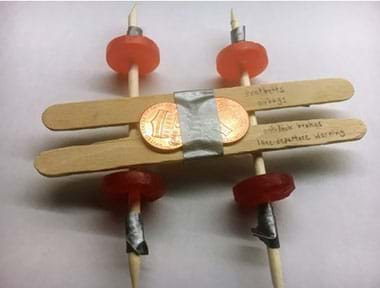
Summary
What can round mint candies and coins teach us about engineering? More than you might think, particularly when it comes to understanding and testing dependent and independent variables! In this activity, students design, build, and test model race cars using simple materials, including lifesaver-shaped candies, plastic drinking straws, Popsicle sticks, index cards, and tape. Working within a budget, students explore trade-offs among performance, safety, materials, and cost, applying the engineering design process by brainstorming, planning, building, testing, and improving their "mint-mobiles." Students then investigate how changes in the mass of their mint-mobiles affect performance. By systematically varying mass and measuring resulting distances traveled, students gain hands-on experience with independent and dependent variables, control conditions, and the iterative nature of engineering design. This activity encourages students to apply principles of physics, such as Newton’s laws and energy transfer, while making evidence-based predictions and optimizations to improve their designs.Engineering Connection
When developing a new product or device, engineers go through many iterations of the engineering design process. First, they imagine lots of ideas and share them with their teammates. The team then decides on one best design and plans its final materials, specifications, functionality and aesthetics. Before building a full-scale prototype, they create a small model on which they perform many tests. This process often involves balancing tradeoffs between optimized performance, safety, and cost. Once a model has been perfected, they build at full scale.
Learning Objectives
After this activity, students should be able to:
- Explain the steps of the engineering design process.
- Define criteria and constraints for a specific design problem.
- Defend design choices considering tradeoffs.
- Describe how Newton’s Laws of Motion apply to their mint-mobile’s movement, including the effects of mass, force, and acceleration.
- Explain the role of energy transfer (potential to kinetic) and friction in determining the distance a mint-mobile travels.
- Analyze real-world data by determining the equation of a line of best fit and use it to predict performance under different conditions.
Educational Standards
Each TeachEngineering lesson or activity is correlated to one or more K-12 science,
technology, engineering or math (STEM) educational standards.
All 100,000+ K-12 STEM standards covered in TeachEngineering are collected, maintained and packaged by the Achievement Standards Network (ASN),
a project of D2L (www.achievementstandards.org).
In the ASN, standards are hierarchically structured: first by source; e.g., by state; within source by type; e.g., science or mathematics;
within type by subtype, then by grade, etc.
Each TeachEngineering lesson or activity is correlated to one or more K-12 science, technology, engineering or math (STEM) educational standards.
All 100,000+ K-12 STEM standards covered in TeachEngineering are collected, maintained and packaged by the Achievement Standards Network (ASN), a project of D2L (www.achievementstandards.org).
In the ASN, standards are hierarchically structured: first by source; e.g., by state; within source by type; e.g., science or mathematics; within type by subtype, then by grade, etc.
NGSS: Next Generation Science Standards - Science
| NGSS Performance Expectation | ||
|---|---|---|
|
HS-ETS1-2. Design a solution to a complex real-world problem by breaking it down into smaller, more manageable problems that can be solved through engineering. (Grades 9 - 12) Do you agree with this alignment? |
||
| Click to view other curriculum aligned to this Performance Expectation | ||
| This activity focuses on the following Three Dimensional Learning aspects of NGSS: | ||
| Science & Engineering Practices | Disciplinary Core Ideas | Crosscutting Concepts |
| Design a solution to a complex real-world problem, based on scientific knowledge, student-generated sources of evidence, prioritized criteria, and tradeoff considerations. Alignment agreement: | Criteria may need to be broken down into simpler ones that can be approached systematically, and decisions about the priority of certain criteria over others (trade-offs) may be needed. Alignment agreement: | |
| NGSS Performance Expectation | ||
|---|---|---|
|
HS-ETS1-3. Evaluate a solution to a complex real-world problem based on prioritized criteria and trade-offs that account for a range of constraints, including cost, safety, reliability, and aesthetics, as well as possible social, cultural, and environmental impacts. (Grades 9 - 12) Do you agree with this alignment? |
||
| Click to view other curriculum aligned to this Performance Expectation | ||
| This activity focuses on the following Three Dimensional Learning aspects of NGSS: | ||
| Science & Engineering Practices | Disciplinary Core Ideas | Crosscutting Concepts |
| Evaluate a solution to a complex real-world problem, based on scientific knowledge, student-generated sources of evidence, prioritized criteria, and tradeoff considerations. Alignment agreement: | When evaluating solutions it is important to take into account a range of constraints including cost, safety, reliability and aesthetics and to consider social, cultural and environmental impacts. Alignment agreement: | New technologies can have deep impacts on society and the environment, including some that were not anticipated. Analysis of costs and benefits is a critical aspect of decisions about technology. Alignment agreement: |
| NGSS Performance Expectation | ||
|---|---|---|
|
HS-PS2-1. Analyze data to support the claim that Newton's second law of motion describes the mathematical relationship among the net force on a macroscopic object, its mass, and its acceleration. (Grades 9 - 12) Do you agree with this alignment? |
||
| Click to view other curriculum aligned to this Performance Expectation | ||
| This activity focuses on the following Three Dimensional Learning aspects of NGSS: | ||
| Science & Engineering Practices | Disciplinary Core Ideas | Crosscutting Concepts |
| Analyze data using tools, technologies, and/or models (e.g., computational, mathematical) in order to make valid and reliable scientific claims or determine an optimal design solution. Alignment agreement: Theories and laws provide explanations in science.Alignment agreement: Laws are statements or descriptions of the relationships among observable phenomena.Alignment agreement: | Newton's second law accurately predicts changes in the motion of macroscopic objects. Alignment agreement: Attraction and repulsion between electric charges at the atomic scale explain the structure, properties, and transformations of matter, as well as the contact forces between material objects.Alignment agreement: | Empirical evidence is required to differentiate between cause and correlation and make claims about specific causes and effects. Alignment agreement: |
| NGSS Performance Expectation | ||
|---|---|---|
|
HS-PS3-3. Design, build, and refine a device that works within given constraints to convert one form of energy into another form of energy. (Grades 9 - 12) Do you agree with this alignment? |
||
| Click to view other curriculum aligned to this Performance Expectation | ||
| This activity focuses on the following Three Dimensional Learning aspects of NGSS: | ||
| Science & Engineering Practices | Disciplinary Core Ideas | Crosscutting Concepts |
| Design, evaluate, and/or refine a solution to a complex real-world problem, based on scientific knowledge, student-generated sources of evidence, prioritized criteria, and tradeoff considerations. Alignment agreement: | At the macroscopic scale, energy manifests itself in multiple ways, such as in motion, sound, light, and thermal energy. Alignment agreement: Although energy cannot be destroyed, it can be converted to less useful forms—for example, to thermal energy in the surrounding environment.Alignment agreement: Criteria and constraints also include satisfying any requirements set by society, such as taking issues of risk mitigation into account, and they should be quantified to the extent possible and stated in such a way that one can tell if a given design meets them.Alignment agreement: | Energy cannot be created or destroyed—it only moves between one place and another place, between objects and/or fields, or between systems. Alignment agreement: Modern civilization depends on major technological systems. Engineers continuously modify these technological systems by applying scientific knowledge and engineering design practices to increase benefits while decreasing costs and risks.Alignment agreement: |
Common Core State Standards - Math
-
Model with mathematics.
(Grades
K -
12)
More Details
Do you agree with this alignment?
-
Use units as a way to understand problems and to guide the solution of multi-step problems; choose and interpret units consistently in formulas; choose and interpret the scale and the origin in graphs and data displays.
(Grades
9 -
12)
More Details
Do you agree with this alignment?
-
Fit a linear function for a scatter plot that suggests a linear association.
(Grades
9 -
12)
More Details
Do you agree with this alignment?
-
Represent data on two quantitative variables on a scatter plot, and describe how the variables are related.
(Grades
9 -
12)
More Details
Do you agree with this alignment?
International Technology and Engineering Educators Association - Technology
-
Students will develop an understanding of the attributes of design.
(Grades
K -
12)
More Details
Do you agree with this alignment?
-
Students will develop an understanding of engineering design.
(Grades
K -
12)
More Details
Do you agree with this alignment?
-
Students will develop abilities to apply the design process.
(Grades
K -
12)
More Details
Do you agree with this alignment?
-
Document trade-offs in the technology and engineering design process to produce the optimal design.
(Grades
9 -
12)
More Details
Do you agree with this alignment?
-
Apply a broad range of design skills to their design process.
(Grades
9 -
12)
More Details
Do you agree with this alignment?
State Standards
Colorado - Math
-
Fit a function to the data; use functions fitted to data to solve problems in the context of the data. Use given functions or choose a function suggested by the context. Emphasize linear, quadratic, and exponential models.
(Grades
9 -
12)
More Details
Do you agree with this alignment?
-
Choose and interpret the scale and the origin in graphs and data displays.
(Grades
9 -
12)
More Details
Do you agree with this alignment?
-
Represent data on two quantitative variables on a scatter plot, and describe how the variables are related.
(Grades
9 -
12)
More Details
Do you agree with this alignment?
Materials List
Each group needs:
- scissors
- paper and pencil
- Design Worksheet, one per student
- (for optional extension activity) Market Your Mint-Mobile Worksheet, one per group
For the entire class to share:
- plastic drinking straws (about 100 total; make sure the straw diameter is smaller than the mint candy’s hole diameter)
- Popsicle sticks (about 60 total)
- Lifesaver-shaped candies, such as Lifesaver® mints (about 100 total)
- index cards or thin cardboard or poster board scraps the size of index cards (about 30 total)
- tape, any type; duct or masking preferred; cut into 15 cm (~6 in) long strips
- ramp, for testing, made from sturdy poster board, rigid cardboard or thin wood
- Gather two pieces of poster board, rigid cardboard, or thin wood of different lengths, for testing the independent variable of ramp length
- masking tape, for securing the ramp
- meter stick, for measuring the distance traveled
- pennies (about 60 total)
- scale (kitchen scale or similar, must be able to measure mass in grams)
- (optional) hot glue gun and glue sticks
- (for optional extension activity)
- markers and/or colored pencils
- scotch tape
- poster board
Worksheets and Attachments
Visit [www.teachengineering.org/activities/view/cub-2538-exploring-variables-mint-mobiles-high-school] to print or download.Pre-Req Knowledge
Ability to make measurements using a meter stick. Knowledge of independent, dependent, and control variables. Knowledge on how to create a scatterplot, plot a (linear) line of best fit, and determine the equation of this line from data.
Introduction/Motivation
(Write Figure 1 on the board as each step is discussed. Start by drawing an arrow in the shape of a circle.)
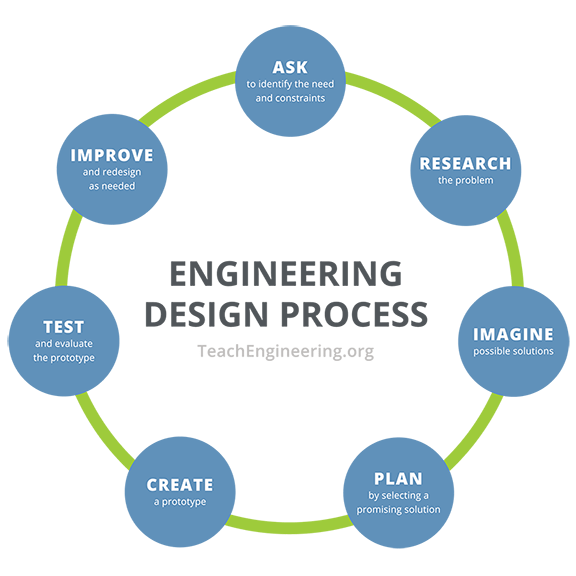
What do you think engineers do first when they begin to create a new product, say a new type of race car, a new style of backpack, or a new type of skis? That's right, the first thing engineers do is ask; that is, they ask what the product will do, what need they are addressing and what others have done. This also requires conducting research of the problem. Then, an engineer imagines all the possible features and qualities of the product. This takes a lot of creative brainstorming! After an engineer has made a list and some sketches of her/his ideas, all of the engineers in a team get together and share what they have come up with. As a team, they plan on one design by working with the best ideas. Once the details of the design have been decided, the team creates the product; then they get to test it out!
Tests are made on models of the product or device, which are often at a smaller than full-scale size. In the testing phase, the team pays attention to what needs to be changed to the model to make the product work better. The last step of the engineering design process is to improve the design.
While the engineering team designs the product, they first think about the criteria and constraints of their design problem. The criteria are all the things required of their product, or what the product must look like or be able to do in order to be considered successful. The constraints are all the things that limit the design. Engineers also balance tradeoffs, or they choose to include one element of a design while sacrificing another of equal importance.
While the engineering team tests the product, they pay close attention to all the variables associated with their design. Two important types of variables are: independent and dependent variables. An independent variable is something that an engineer decides to change during each test to see how the results differ. A dependent variable is something that changes as a result of varying the independent variable. In testing, we also have what is called a control. A control is the part of the experiment that is neither changed by the engineer nor is affected by the independent variable. Engineers are careful to only change one independent variable at a time while testing the product. In this activity, students will investigate how mass affects the motion of their mint-mobiles. They will explore how forces, friction, and energy transfer (potential energy converting to kinetic energy) affect the distance traveled, applying Newton’s Laws of Motion to interpret their results.
Today, you will act as engineers to design, build, and test mint-mobiles. Working within a budget, you’ll need to consider tradeoffs such as cost versus performance or safety versus speed. You will test your designs multiple times, iterating to improve performance, and then investigate how changing the mass of your mint-mobile affects its motion down a ramp. You’ll analyze your results, make predictions, and apply physics concepts to explain the outcomes. Are you ready to brainstorm? Great! Let's get started!
Procedure
Background
Engineers use the engineering design process when they are creating new devices. The main seven steps of the engineering design process are: ask, imagine, research, plan, create, test, and improve The improving step involves starting over again at the beginning of the design process with "ask," that is, "Where does this device need improvement? How can it be made to perform better?" Once a device has been built the first time, it is never complete! Engineers are always improving what they design. Imagine if the cellular phone had never been improved. Or cars, or computers.
Understanding forces and motion is critical in engineering. Newton’s Second Law of Motion states that the force applied to an object is equal to its mass multiplied by its acceleration (F = ma). When designing a vehicle, changes in mass affect acceleration and, therefore, distance traveled. Heavier objects have more potential energy at a given height, which converts to kinetic energy as they move. Engineers also consider friction, which resists motion and reduces distance traveled.
Designing a device often requires tradeoffs. Adding safety features, for instance, increases mass, which may improve stability but reduce speed or increase material costs. Engineers weigh performance, safety, and cost when making design decisions.
To evaluate performance, engineers test different variables. The independent variable is the factor changed deliberately, the dependent variable is the outcome measured, and control variables are factors kept constant to ensure a fair test. Changing only one independent variable at a time allows engineers to isolate its effect on performance.
Engineers analyze results using graphical methods. A scatterplot shows the relationship between variables, and a line of best fit summarizes trends. The slope (m) represents the rate of change, and the y-intercept (b) is the starting value when the independent variable is zero. Using the linear equation y = mx + b, engineers can predict performance under new conditions.
By combining the engineering design process, forces and motion, tradeoffs, and data analysis, students gain a foundation in how engineers make decisions and predict real-world outcomes.
Before the Activity
- Gather materials; place them in a central location in the room.
- Cut masking or duct tape into 15 cm strips.
- Set up the testing ramps by placing sturdy poster boards or a thin wooden board at an angle over a smooth surface (such as a tabletop). Use tape to secure the ramp. Tape a meter stick from the bottom of the ramp along the table, so students can measure the distances traveled.
- Divide the class into teams of two students each.
With the Students
- Distribute copies of the Design Worksheet to students. Make sure students see that they have a $20 budget and they must purchase materials and safety features; the costs of these are given on the Design Worksheet.
- Give students the criteria that their designs must include at least 2 safety features in addition to the required seatbelts and airbags. Ask students to define other criteria and constraints of their mint-mobile design problem. Record student ideas on the board, and have students record their ideas in the Design Worksheet. Ensure that students mention the budget constraint. Student-generated criteria may include: must be roll down the ramp smoothly, must travel in a straight line (not fall off the ramp), mustn’t fall apart, etc. Student-generated constraints may include: can only use given materials, car must be small enough to fit on the ramp, etc. Remind them that physics principles like energy transfer, mass, and friction will influence performance.
- To begin planning their mint-mobile designs, give the class three minutes for students to individually brainstorm what their designs might look like on their Design Worksheets. Point out the list of available materials and safety features on their worksheets and remind students of the criteria and constraints of their design.
- Next, working with their partners, direct students to share their ideas and make drawings of their final, agreed-upon designs on their Design Worksheets. Require the drawings to list the materials and amounts needed to build their mint-mobiles, included safety features, and the total cost of their designs. Remind students that when they are selecting a material over a safety feature, or one safety feature over another, they are making a trade-off between two things that are useful to their designs.
- Once teams have finished their designs, allow them to “buy” materials and safety features. Give students up to 20 minutes to build their initial design.
- Have students test their mint-mobiles by rolling them down the ramp three times and recording the distance traveled. Allow students time (up to half an hour) to record data and modifications on their Design Worksheet and to modify their designs to ensure they meet the criteria recorded on the board. Students may modify their designs after each test. As students test their designs, walk around the room and ask them to explain how/why they are (or are not) changing their designs. Encourage students to defend their design decisions and for each team member to answer your questions. Encourage students to explain how mass, ramp angle, friction, and energy transfer influence design changes.
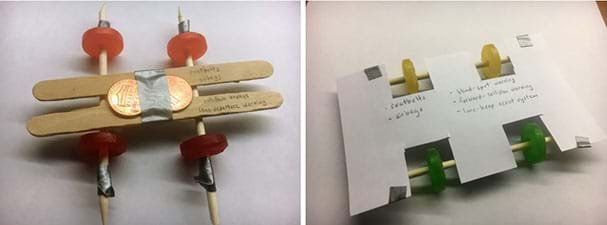
- After students have tested their designs, tell them, “Engineers are also interested in how different variables affect their design’s performance. Now that we’ve created some mint-mobiles, we’ll investigate how changing the mass affects how far the mint-mobiles can travel.”
- Have students begin testing the independent variable of mint-mobile mass, following the procedure and recording data in their Design Worksheets. Students will test their mint-mobiles at various masses three more times. Ensure students are carefully recording data on their worksheets, using the scale to measure mass and the meter stick to measure distance traveled.
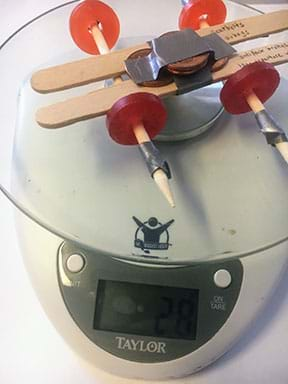
- After testing, students will graph their data, draw a line of best fit, and determine the equation of the line. Assist students as needed, making sure they clearly label the graph and helping them determine the line equation.
- Tell students that they will now use their equations to predict the performance of their mint-mobiles at a new mass. Make sure students choose a mass they did not test earlier.
- Have students test their predictions by adding (or removing) mass from their mint-mobiles to match the new mass chosen. Students will send their mint-mobiles down the ramp again and record the distance traveled. Ensure that students compare their prediction to the actual distance traveled by writing their reflections on their worksheets.
- Have students set their mint-mobiles aside and complete the ‘Reflection’ section of their worksheets. Give students up to 10 minutes to reflect within their groups, then bring the class together and ask each group to share their reflections on the engineering design process. Students should describe how mass, materials, and ramp conditions influenced motion, how potential energy converted to kinetic energy, and how tradeoffs affected outcomes.
Vocabulary/Definitions
brainstorming: A technique of solving specific problems, stimulating creative thinking and developing new ideas by unrestrained and spontaneous discussion.
control variable: A variable that is neither changed by the engineer/tester nor affected by the independent variable.
dependent variable: A variable that changes as a result of changing the independent variable.
energy transfer: The conversion of energy from one form to another, e.g., potential to kinetic energy.
engineering design process: The cycle engineers go through while creating a new device: Ask; Research; Imagine; Plan; Create; Test; Improve.
independent variable: A variable that is intentionally changed by the engineer or tester.
Line of best fit: A line that best represents the trend in a scatterplot.
Newton’s Laws of Motion: Three principles that describe how forces affect the motion of objects.
trade-off: Sacrificing one asset to gain another that is considered equally valuable or useful.
variable : Something that changes while testing an idea, device or system.
Assessment
Pre-Activity Assessment
Identifying Criteria & Constraints: Tell students that engineers often work with criteria and constraints. Have students think-pair-share about what these are in the context of an engineer designing a roller coaster. (Possible criteria: include a large drop, lots of loops, long stretch so the cart can go fast, etc. Possible constraints: cost, amount of space available to build the coaster, other similar coasters nearby, safety requirements, etc.) Encourage students to consider how factors like energy, motion, and forces might influence design choices.
Activity Embedded Assessment
Recording Design & Data: Have students complete the Design Worksheet as they work through the activity. Ensure each student has a chance to test their mint-mobiles and record data individually. Students should document observations about how changes in mass, ramp angle, or other design choices influence the distance traveled, connecting these to energy conversion, friction, and Newton’s laws of motion.
Post-Activity Assessment
Class Discussion: Ask students the following questions and discuss as a class.
- What were the independent, dependent and control variables in the Variables Test part of the activity? (Answer: The independent variable was the mass of the mint-mobile, the dependent variable was the distance the cart travels, and the controls included the length and angle of the ramp.)
- How did your groups’ predicted distance compare to the actual distance? Why were your predictions close/far from the actual value? (Answers may vary. Possible answer: The predicted distance was shorter than the actual distance. Our prediction didn’t take into account how bumpy the trip down the ramp was, which slowed down our mint-mobile and caused it to not go as far.)
- How could you design a mint-mobile to travel a longer distance than any of the mint-mobiles you made or saw today? (Have students brainstorm and share ideas; remind students that engineers always look for ways to improve their designs, including collaborating with other teams.)
- What steps did you follow in the engineering design process? (Have students share their own experiences, in their own words, that describe the repeating seven-step-loop of the engineering design process: ask, imagine, research, plan, create, test, and improve.)
Investigating Questions
What other independent variables could affect the distance traveled by the mint-mobiles? (Possible answers: The material used on the ramp, the type of materials used to build the cart, the slope and length of the ramp, the number of wheels, the stability of the cart.)
What is another dependent variable in this activity that might be of interest to an engineer designing a real race car or roller coaster cart? (Possible answers: Speed, stability.)
What are the dependent variables that would be affected by these changes? (Possible answers: Speed, distance traveled, and stability.)
Troubleshooting Tips
If students use the straws as axles and find that the straws are bigger than the candy hole diameter, they can use scissors to slit the straws lengthwise, then curl and tape them tighter (so they are narrower) to make straws that spin better in the candy holes.
The mint-mobiles roll best on smooth surfaces rather than the textured surfaces of carpets, so build the testing ramp on a tabletop and place a thin poster board at the bottom of the ramp.
If students' mint-mobiles are quite small, they may not be able to hold many pennies. If so, tape on a few pennies at a time to determine a reasonable maximum amount.
Activity Extensions
Team Test Your Instructions: In addition to each team designing a mint-mobile with a sketch and list of materials (see the Design Worksheet), have them write instructions on how to build the mint-mobile and exchange designs with another group. Tell the students to build the other team's mint-mobile following the instructions using only the supplies listed. This exercise sharpens students' awareness of the importance of accuracy and clear communication in their engineering plans. Or similarly, conduct The Universal Language of Engineering Drawings activity, in which students practice the ability to produce clear, complete, accurate and detailed design drawings for a mint-mobile-type model car, using only specified materials. Teams trade drawings and attempt to construct the model cars in order to determine how successfully the original design intentions were communicated through sketches, dimensions and instructions.
Market Your Mint-Mobile: Have students create a poster to market their mint-mobiles. See the Market Your Mint-Mobile Worksheet for directions and a poster grading rubric. Have students present their posters to their classmates.
Activity Scaling
- For lower grades, remove the first three design process/modification tests and focus on testing variables; see Exploring Variables While Testing & Improving Mint-Mobiles (for Elementary School). Or, still focusing on testing variables, allow students to choose an independent variable to test; see Exploring Variables While Testing & Improving Mint-Mobiles (for Middle School).
- For upper grades, remove the activity scaffolding: only provide the first page of the Design Worksheet and a few sheets of graph paper. Write the steps of the engineering design process on the board and encourage students to go through the steps on their own.
Subscribe
Get the inside scoop on all things TeachEngineering such as new site features, curriculum updates, video releases, and more by signing up for our newsletter!More Curriculum Like This

Students design, build, and test model race cars made from simple materials (lifesaver-shaped candies, plastic drinking straws, Popsicle sticks, index cards, tape) as a way to explore independent, dependent and control variables.

Build a model race car out of lifesaver candies, popsicle sticks, straws, and other fun materials! Have students learn about independent, dependent, and control variables, and find out who can make the fastest car given their new knowledge.

Learn the basics of the analysis of forces engineers perform at the truss joints to calculate the strength of a truss bridge known as the “method of joints.” Find the tensions and compressions to solve systems of linear equations where the size depends on the number of elements and nodes in the trus...

High school students learn how engineers mathematically design roller coaster paths using the approach that a curved path can be approximated by a sequence of many short inclines. They apply basic calculus and the work-energy theorem for non-conservative forces to quantify the friction along a curve...
Copyright
© 2020 by Regents of the University of ColoradoContributors
Lesley Herrmann; Denise W. Carlson; Stephanie Rivale; Sabina SchillSupporting Program
Integrated Teaching and Learning Program, College of Engineering, University of Colorado BoulderAcknowledgements
The contents of this digital library curriculum were developed under grants from the Fund for the Improvement of Postsecondary Education (FIPSE), U.S. Department of Education, and National Science Foundation (GK-12 grant no 0338326). However, these contents do not necessarily represent the policies of the Department of Education or National Science Foundation, and you should not assume endorsement by the federal government.
This curriculum was revised and adapted in 2020 from its original to serve high school students by TeachEngineering.org.
Last modified: September 4, 2025






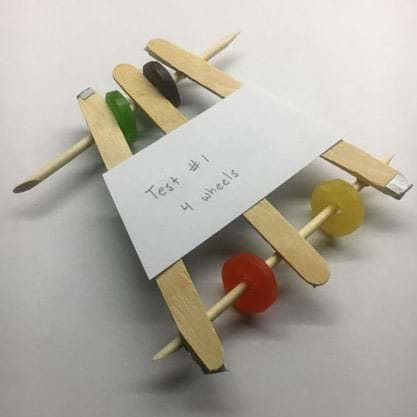

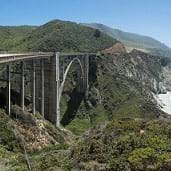

User Comments & Tips